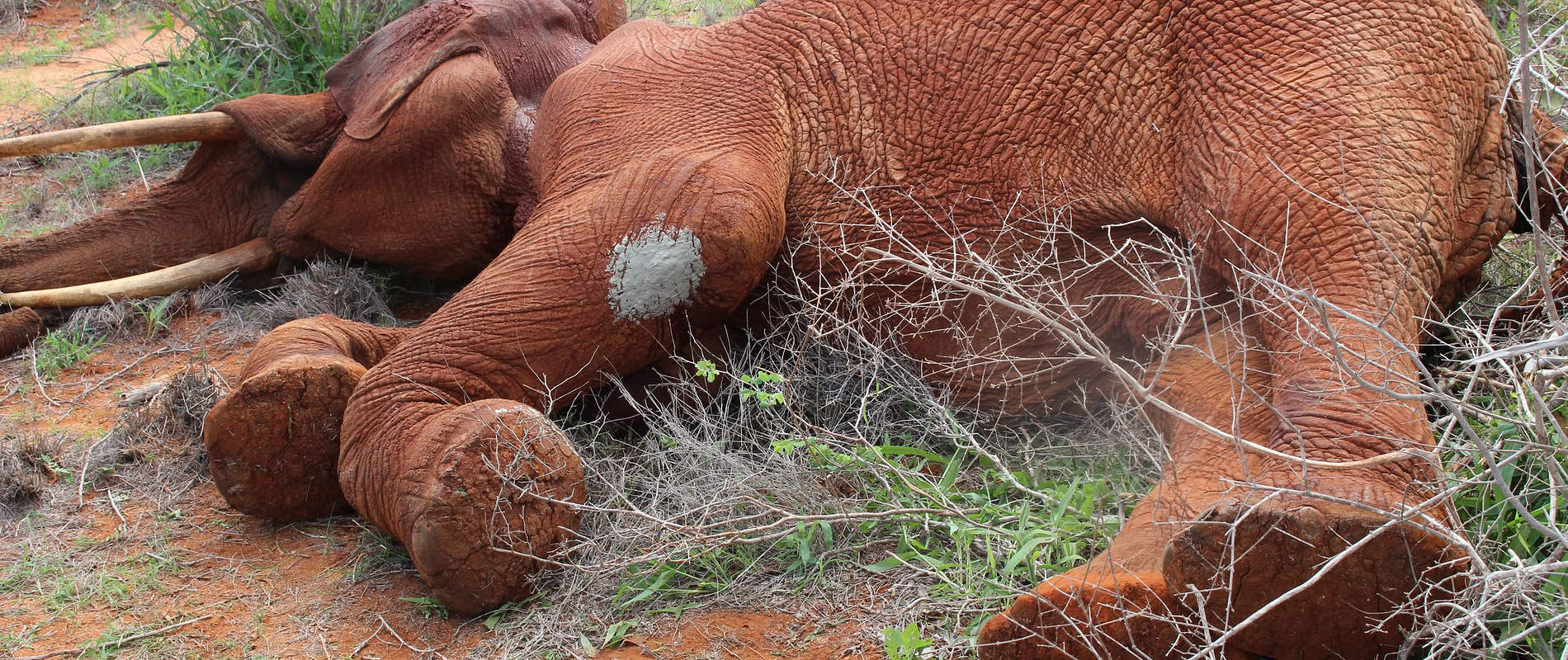The month of November witnessed the start of short rains with some showers observed in Aruba and triangle areas of Tsavo East National Park and Taita ranches
The month of November witnessed the start of short rains with some showers observed in Aruba and triangle areas of Tsavo East National Park and Taita ranches. The few showers,although much needed, were too little to end drought related deaths ravaging Tsavo East National Park. In the month under review an elephant calf was rescued near Charlie zero near Galana River and another in Luggards falls both in Tsavo East and taken to Nairobi. A problematic lion from Malindi was also captured and brought to Tsavo vet and was euthanized due to amputation of the forelimb by a wire snare. In other cases, a weak elephant calf was rescued from pipeline area of Tsavo east and taken to Voi stockade while recumbent elephants in Aruba and Sobo areas were also attended to.
A week-long exercise of rhino ear notching and transmitter fitting was undertaken within the Ngulia Intensive Protection Zone (IPZ) and sanctuary where a total of 24 rhinos were either ear notched (sanctuary) or fitted with transmitter and ear notched (IPZ). The long sought snared rhino within the IPZ was finally located and treated from the traumatizing neck wire snare with good prognosis. Finally, the unit treated 2 elephant bulls in Ithumba and Sobo areas of Tsavo East with suspected bullet wounds.
1. RESCUE OF AN ELEPHANT CALF
Animal: African Elephant
Species: Loxodanta Africana
Sex: Male
Age: 1 year
Location: Charlie zero Galana River, Tsavo East.
Date: 1st November
History, treatment and rescue
A report was made by DSWT director that while flying along Galana River, in Tsavo East, they spotted a small elephant calf that was abandoned and in company of three big bulls. The vet was airlifted by DSWT aeroplane from Voi to the area to coordinate the rescue.


A DSWT Helicopter was on standby to assist with the rescue. The chopper was used to separate the calf from the bulls and a team on the ground captured the calf and restrained it. He was administered long acting antibiotics, Vitamin B12 complex and Dexamethasone Hcl. The calf was loaded onto a waiting DSWT chopper and airlifted direct to DSWT orphanage in Nairobi for care and eventual release back to the wild.
2. RESCUE OF AN ELEPHANT CALF
Animal: African Elephant
Species: Loxodanta Africana
Sex: Male
Age: 2 years
Location: Luggards, Tsavo East.
Date: 2nd November
History, treatment and rescue
A report was made by DSWT patrol plane that while flying along Galana River, Tsavo East where they spotted a small elephant calf that was all alone. The vet team together with Voi stockade staff rushed to the area to find the calf.
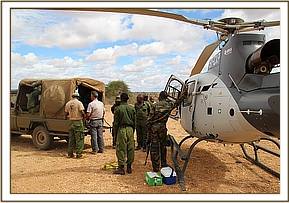
A DSWT Helicopter was on standby to assist with the rescue. The team captured the calf and restrained it. He was administered long acting antibiotics, Vitamin B12 complex and Dexamethasone Hcl. The calf was loaded onto a waiting DSWT chopper and airlifted direct to DSWT orphanage in Nairobi for care and eventual release back to the wild.
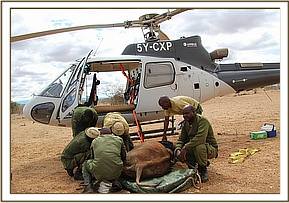
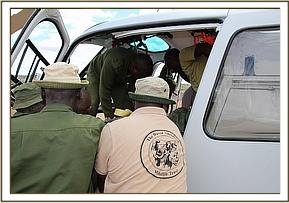
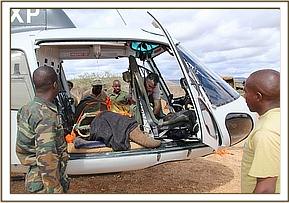


3. EXAMINATION OF A SICK HIPPO
Animal: Hippopotamus
Species: Hippopotomus amphibius
Sex: Male
Age: Adult
Location: Galana conservancy, Tsavo East
Date of clinical intervention: 4th November 2017
History and Examination
A report was made by tourists of a sick and stranded Hippo in Galana conservancy that is adjacent to Tsavo East National Park. The Hippo was slightly submerged in a shallow water after the rains. Tsavo vet unit team rushed to the area to ascertain the problem.
The Hippo was found in the shallow water collection appearing very weak and emaciated. Probing and close examination revealed very poor body condition due to the drought effects and paralysis of the hind limbs. The prognosis of the hippo recovering was put as poor hence a decision was made to euthanize to reduce animal suffering.
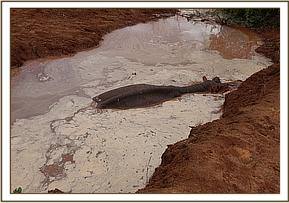

The cause of death was drought related.
4. ELEPHANT CALF RESCUE
Species: Elephant
Sex: Female
Age: 3 years old
Date: 8th November 2017
Place: Sobo, Tsavo East
History, treatment and rescue
A report was made by KWS teams of one elephant calf that was all alone in Sobo area of Tsavo East. The vet team together with the Voi stockade team rushed to the area to find the young elephant foraging alone, emaciated and weak.
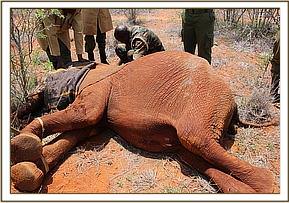

The calf was captured and loaded to a pickup truck thereafter administered with antibiotics, Vitamin B12 complex and colvasone. Having the calf stabilized she was transported to Voi stockade for more intensive care.
5. PROBLEMATIC LION FROM MALINDI
Animal: Lion
Species: Panthera leo
Sex: Male
Age: Adult
Location: Magarini, Malindi
Date of intervention: 10th November 2017
History, Capture and Translocation
Then lion was trapped and captured by the KWS rangers after preying on livestock within Magarini area of Malindi. It was brought to Tsavo vet unit for examination and eventual release back to Tsavo East National Park. A dart was prepared containing 300 mgs of Ketamine Hcl and 4 mgs Meditomidine Hcl and the lioness darted. Close examination revealed complete amputation of the right paw at the ankle by suspected wire snare with some healing.
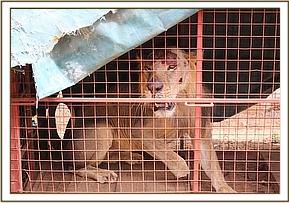

With such a serious injury, the predator could not hunt wild prey and hence resorted to livestock predation as a way of feeding itself and running into conflict with the community. With that in mind a decision was made to euthanize the lioness.
6. EXAMINATION OF AN ELEPHANT COW
Date: 11th November 2017
Species: Loxodanta Africana (African Elephant)
Sex: Female
Age: Adult
Location: Aruba, Tsavo East
History
Report was received from tour drivers of a weak elephant cow that was recumbent and flat on the ground near Aruba lodge within Tsavo East. The team rushed to the area and found the cow flat on the ground with poor body condition.
Examination and treatment
Treatment with antibiotics, colvasone, vitamin B12 complex and Dextrose IV bolus shots were administered but the response was minimal. Attempts to pull her onto her feet also proved unsuccessful. With poor prognosis she was euthanized and the tusks removed for safe custody. The poor condition is drought related though the recent rain has not been sufficient to get her health back.
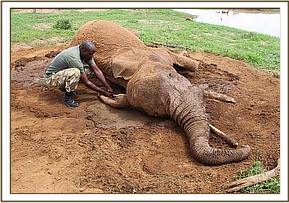

7. RESCUE OF AN ELEPHANT CALF
Animal: African Elephant
Species: Loxodanta Africana
Sex: Female
Age: 3 Years
Location: Pipeline, Tsavo East.
Date: 12th November
History, treatment and rescue
A report was made by tourists of an elephant calf seen along pipeline road in company of some bulls and at times alone inside Tsavo East. The vet team together with the Voi stockade searched for the young Elephant and finally found her all alone. The calf was covered with a blanket, captured and taken to Voi stockade where administration of antibiotics, Vitamin B12 complex and colvasone was instituted. The calf stabilized and was transported to Voi stockade with the assistance of the Voi stockade team for more intensive care. She is so far doing well.
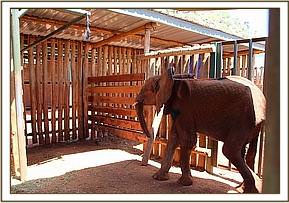

8. EXAMINATION OF ELEPHANT COW
Animal: African Elephant
Species: Loxodanta Africana
Sex: Female
Age: Adult
Location: Sobo, Tsavo East
Date of clinical intervention: 13th November 2017
History and Examination
A report was made by DSWT aeroplane of a recumbent Elephant near Sobo within Tsavo East National Park. The Tsavo unit team unit visited the area to ascertain the cause.
The Elephant cow appeared weak but was struggling to stand up. Treatment with antibiotics, colvasone, vitamin B12 complex and Dextrose IV bolus shots were administered but the response was minimal. A rope tied to the vet unit vehicle and looped on her tusk was used to aid her onto her feet.
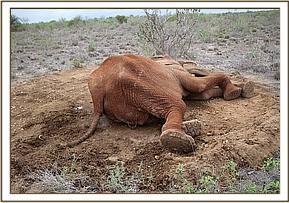

She stood up and walked away slowly but again collapsed. Further attempts proved futile. The cow was euthanized and tusks removed for safe custody. Some showers were witnessed in Tsavo East National Park and we hope it will continue and we believe the drought related Elephant suffering will end.
9. TREATMENT OF AN ELEPHANT BULL
Date: 14th November 2017
Species: Loxodanta Africana (African Elephant)
Sex: Male
Age: Adult
Location: Ithumba, Tsavo East
History
Report was received from DSWT Ithumba team of an injured Elephant bull that was badly lame near the Ithumba Elephant stockade. The Vet who was in Nairobi was airlifted to Ithumba and found the bull nearby in a bush.
Immobilization, examination and treatment
Treatment
Etorphine Hcl(0.98%) (M99®) 18 mgs 1.5 ml Dan - inject dart was prepared. Helicopter darting was carried out. Using a Dan inject® dart rifle (Dan-inject APS, Sellerup Skovvej, Denmark) the Elephant was darted and pushed by the chopper to an open and went down on lateral recumbency after 8 minutes. There was a deep penetrating wound on the left forelimb near the elbow joint with pus oozing out and swelling of the joint. The wound was washed clean with water mixed with hydrogen peroxide, necrotic tissues and pus were removed and the wound doused with tincture of iodine. Green clay was used to cover the wound. Long acting antibiotics were administered IM and intravenous administration of dexamethasone Hcl given through the ear vein after which the anaesthesia was reversed by administration of diprenorphine. Prognosis is guarded.Anaesthesia was reversed using Diprenorphine at 3 times the etorphine dose and the Elephant stood up and walked away.


10. NGULIA RHINO EAR NOTCHING AND TRANSMITTER FITTING, TSAVO WEST
Date: 20th-27th November 2017
Species: Black Rhino (Diceros bicornis)
Sex: Both sexes
Age: Adult and sub adults (24)
Location: Ngulia, Tsavo West
History
Successful biological management of rhinos requires good quality data to inform decision making. The information required for efficient rhino protection and meta-population management is obtained by maintaining a standardized high-quality monitoring system.
One of the activities undertaken to achieve this is to maintain regular ear notching of the population. The aim remains to ensure over 60% of individual rhinos can be independently recognized by the rhino monitoring team at all times. This is outlined in the conservation and management strategy for the black rhino (2018 – 2022). Ear notching will enhance monitoring by increasing daily sightings intervals for all rhino individuals. This is done through ear notching where V- shapes are notched in specific parts the ear. Each rhino is given a unique pattern (number) to enable positive identification. During the exercise, a total of twenty-four (24)rhinos werecaptured: twelve (12) of them being ear notched at NRS; and twelve (12) were ear notched and fitted with transmitters in the IPZ
Immobilization, fitting and reversal
After the target is positively identified, it is first driven towards open ground and darted from a helicopter. Immobilization is achieved using a drug combination of Azaperone Hcl 80mg (Kyron laboratories (pty) Ltd) and Etorphine Hcl 4.5 mg (Captivon® 98, Wildlife pharmaceuticals (Pty) Ltd) with Hyaluronidase 2000 for the adults and 2.5-3.5 mgs Etorphine Hcl and 50-60 mgs Azaperone for the young and sub-adult Rhinos respectively delivered by a Dan Inject dart gun. Induction time ranged from 4 to 8 minutes with a mean of 6 minutes and 7 to 10 minutes for Notching and transmitter fixing respectively. After being immobilized, the ground team moves in quickly to process the animal. Vital parameters including respiration rate and temperature are monitored routinely in immobilized animals. To control hyperthermia, immobilized animals were liberally doused with water. A blindfold was also used to prevent damage to the cornea and to minimize visual stimulation. After confirming that the animal is in a stable condition, ears were notched using a predetermined pattern.
Haemostatic forceps were used to control bleeding and topical antibiotic spray (Alamycin, Norbrook ltd) applied on wounds. Six transponders (microchips) were fitted to the animal; one in each horn, two in the neck and another two at the base of the tail. Various samples including blood for biochemical and serological analysis, feces (per rectum), tissue samples (notched ear tissue) and tail hair were collected from the animal. Prophylactic treatment against trypanosomiasis, Berenil® 4200mg (Intervet International Ltd), was administered intramuscularly to animals and a long acting amoxicillin based antimicrobial (Betamox®) was administered deep intramuscularly for prophylaxis against opportunistic infections that can arise due to capture related stress.
After the operation is over, the vet then wakes up the Rhino after all is clear using Diprenorphine Hcl (Activon® Wildlife pharmaceuticals (Pty) Ltd) administered through the ear vein at three times the Etorphine dose. The Rhino is then observed until it fully awake and walking for the team to embark on the next animal.
Injured Rhino case
During the exercise, a rhino with a wire snare around its neck was spotted near Rhodesia hill in the IPZ and treated. After being darted as explained above the wire snare was cut loose, wound around the neck washed with water mixed with hydrogen peroxide at a ratio of 1:1, wound doused with tincture of iodine and finally spayed with Oxytetracycline antibiotic spray.
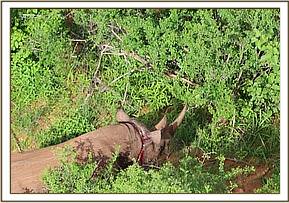
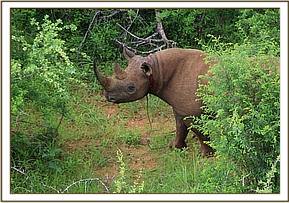
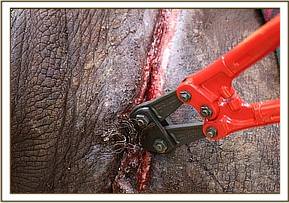
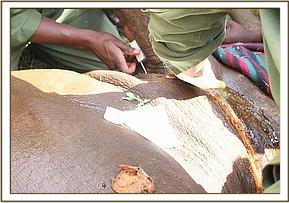

A cover of wetted green clay with wound healing properties was smeared on the wound to keep off flies and aid quick healing. Long acting antibiotics and Dexamethasone Hcl was administered by deep muscle injections. Anaethesia reversal was done as explained before and the Rhino woke up well. Prognosis is good.
11. TREATMENT OF AN ELEPHANT BULL
Date: 30th November 2017
Species: Loxodanta Africana (African Elephant)
Sex: Male
Age: Adult
Location: Sobo, Tsavo East
History
Report was received from DSWT patrol aircraft of an injured Elephant bull that was limping badly in Sobo area of Tsavo East. The Vet team rushed to the area and found the bull near the said location with carrying leg lameness and barely unable to walk.
Immobilization, examination and treatment
Etorphine Hcl(0.98%) (M99®) 18 mgs 1.5 ml Dan - inject dart was prepared. Vehicle darting was carried out. Using a Dan inject® dart rifle (Dan-inject APS, Sellerup Skovvej, Denmark) the Elephant was darted and went down on lateral recumbency after 5 minutes. There was a deep penetrating wound on the left forelimb behind elbow joint with watery blood oozing out and swelling of the joint.
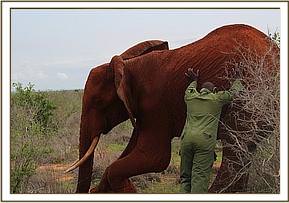
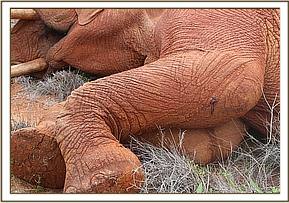


The wound was washed cleaned using normal saline water and doused with tincture of iodine. Green clay was used to cover the wound. Long acting antibiotics were administered IM and intravenous administration of dexamethasone Hcl given through the ear vein after which the anaesthesia was reversed by administration of diprenorphine.
Prognosis is guarded to poor.Anaesthesia was reversed using Diprenorphine at 3 times the etorphine dose and the Elephant stood up and walked away.
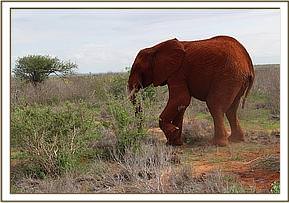

OTHER ACTIVITIES UNDERTAKEN
The unit examined several wildlife trophies/parts and produced expert reports to aid in prosecution of the offenders in court and testified in court on the same.
The unit treated a DSWT security dog in Ngulia and Kaluku for various ailments.
